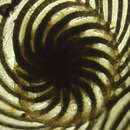tr
kırıntılardaki isimler


Cycloputeolina discoidea has a planispiral, discoidal test. The juvenile stage is involutely coiled with curved chambers. The coiling then shifts from an involute mode to an evolute mode. Successive chambers are flabelliform and reniform in shape. The final ontogenetic stage is comprised of annular, or ring-shaped, chambers. The involute stage is biconvex and lenticular in shape with a keeled periphery. Subsequent stages are biplanar and compressed. Chambers are greater in width than height and of relatively uniform height. The chamber surface is slightly inflated. Randomly distributed pseudopores cover the entire chamber surface. The interior of the chambers is undivided, and lacks septa, walls or pillars.
There are multiple apertures per chamber. The apertures are round to oval in shape and bordered by a round, elevated, imperforate rim. The apertural face is ornamented with irregularly shaped, haphazardly dispersed pseudopores. A single row of apertures is present along the periphery of the last-formed chambers.
Cycloputeolina was described as a new genus by Seiglie & Grove in Seiglie et al. (1977: 864). The type species by original designation is Peneroplis pertusus var. discoideus Flint, 1899. The original description is as follows: “Test large, discoidal, with the swollen central portion corresponding to the involute early stage; proloculus followed by a flexostyle generally shorter than half the circumference of the proloculus and then by an involute planispiral stage consisting from one to two and a half whorls; then reniform and annular chambers; the last planispiral chambers and all the reniform and annular chambers subdivided by two sets of alternating intradermal plates; aperture consists of one or two rows of orifices surrounded by a lip in a central peripheral sulcus.”